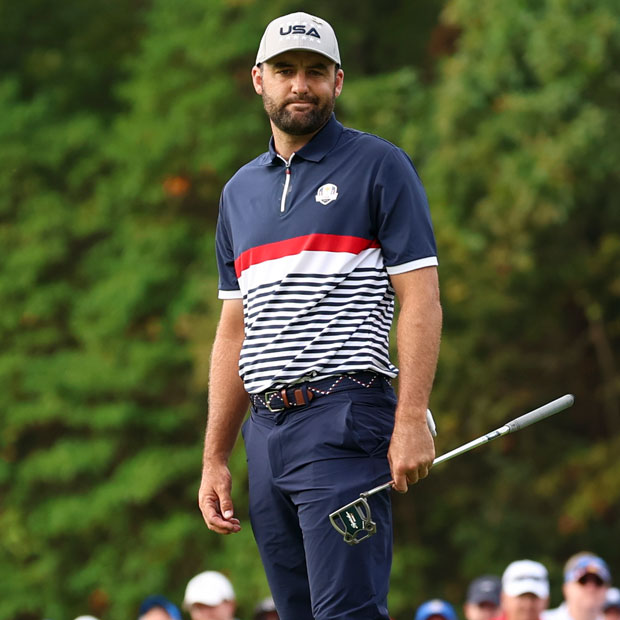Gamble Sands (Sands Course)
Gamble Sands may have introduced a kinder, gentler David McLay Kidd, but it has just enough bite to make a lower-than-usual score feel like an accomplishment

Brewster, Washington, USA
David McLay Kidd (original design, 2014)
Public
$$
The Gebbers family, which owns an apple- and cherry-farming empire based in Brewster, Washington, had little connection to golf before founding Gamble Sands a decade ago. However, from watching the rapid success of Mike Keiser’s Bandon Dunes, they understood the power of a core-golf experience to draw wealthy clientele to a remote location. In the early 2010s, the Gebberses hired David McLay Kidd, Bandon’s first architect, to jump-start their own resort on a sandy bluff overlooking the intersection of the Columbia and Okanagan rivers. Kidd was at a turning point in his career, aware that his work in the late aughts at Tetherow and the Castle Course at St. Andrews had earned him a reputation as a designer of difficult, overcooked courses. At Gamble Sands, he reinvented himself as a purveyor of fun and straightforward golf: forgiving fairways, clear-cut risk-reward options, and large greens with helping contours. The design delighted many average golfers, including Keiser himself, who soon tapped Kidd to build the second course at Sand Valley.
{{content-block-course-profile-gamble-sands-sands-course-001}}
Take Note…
Make an entrance. David McLay Kidd’s first decision at Gamble Sands was where to put the entrance road. Climbing straight up from Highway 17 was the shortest and cheapest option but would have cut through some appealing golf terrain. Ultimately, Kidd advised the Gebbers family to construct a four-and-a-half mile road looping up from the highway and around the back of the property. The extended drive is an appealing part of the Gamble Sands experience today; it builds anticipation and saves the best views for when you exit your car and walk toward the course.
Traffic. Initially, Kidd wanted Gamble Sands to be walking-only, but after spending a few hot summer days on site, he saw that carts would be a necessity. The resort opened with a limited number of carts but quickly found that this small fleet couldn’t accommodate guest demand. Today, according to an employee I spoke with, about 85% of players choose to ride.
Right-hand man. Nick Schaan, who played a key role on the Gamble Sands project, first worked for Kidd during the construction of Huntsman Springs, now known as Tributary, in Idaho. That course opened in 2010, and Schaan has been a fixture on Kidd’s construction sites ever since. Today he is a partner in the firm—the Wagner to Kidd’s Hanse.
Favorite Hole
No. 8, par 4, 213-310 yards
Like the much-photographed second hole, No. 8 at Gamble Sands travels west to the edge of the river gorge and plays for most as a drivable, or nearly drivable, par 4. It’s a testament to Kidd’s skill that the two holes feel totally distinct and that the eighth, the far less spectacular of the two, is just as fun to play.
Favorite Hole
No. 8, par 4, 213-310 yards
Like the much-photographed second hole, No. 8 at Gamble Sands travels west to the edge of the river gorge and plays for most as a drivable, or nearly drivable, par 4. It’s a testament to Kidd’s skill that the two holes feel totally distinct and that the eighth, the far less spectacular of the two, is just as fun to play.
From the tee, much of the hole is obscured—an unusual circumstance at Gamble Sands—but the three center-line bunkers, each built up just enough to be visible, provide clear guidance. If you take on the blind carry left of the bunkers while avoiding the hazards on both sides, your ball may trundle onto the green. Going right of the bunkers offers more room for error but takes eagle (or an easy birdie) off the table.
The green is one of the Kidd team’s more successful shaping efforts. It sits elegantly at grade, surrounded by subtly contoured short grass. The humps and runoffs along the right side make pitches from the conservative landing zone somewhat tricky.

{{content-block-course-profile-gamble-sands-sands-course-002}}
Overall Thoughts
David McLay Kidd launched the second act of his career at Gamble Sands. Over the previous decade, he had become known for designing bold, difficult golf courses—perhaps too bold and too difficult. By the time the Great Recession hit, the developers who had championed Kidd early in his career, most significantly Mike Keiser, were giving their best sites to Coore & Crenshaw and Tom Doak, architects whose courses treated average golfers gently. Kidd found himself on the wrong side of industry trends. So with his design at Gamble Sands, he made an about-face, emphasizing playability to an even greater degree than Coore & Crenshaw or Doak. His fairways were wider, his greens more receptive, his drivable par 4s more drivable than anyone else’s. Players voted with their feet, and Kidd was back on top.
This is a familiar story by now, and it’s basically accurate, but it doesn’t fully explain Kidd’s current ideas about golf architecture. His philosophy is more interesting and daring than it is usually portrayed, which isn’t to say I find it completely persuasive.
When people talk about Kidd’s new phase, they tend to focus on two things: wide fairways and big greens. These components are undoubtedly important, lending his recent courses their trademark forgiveness and fun factor. But Kidd insists that other modern architects build fairways just as wide and greens just as big, and he’s right. See: Kapalua, Old Macdonald.
According to Kidd, what really sets him apart from his contemporaries is his willingness to show width and bigness to the player. Coore & Crenshaw and Doak, in contrast, have an affinity for visual deception. If a shot is easy, it won’t appear so. A fairway may be massive, but most of it will be concealed from view; a green may be easy to hit, but it will look like a postage stamp until you reach its surface. In this way, today’s neoclassical architects, like Alister MacKenzie before them, achieve playability while posing a mental challenge. Golfers have room to make mistakes, but they need to overcome the fear and self-doubt that the design continually stokes within them.
Kidd’s most radical move at Gamble Sands was to reject this line of thinking, to turn his back on the tradition of visual deception. Rather than tricking players into feeling anxious and timid when they shouldn’t, he wanted to boost their confidence, to get them swinging freely. So not only were Kidd’s fairways wide and his greens big, but they also looked that way. If he could encourage golfers to play aggressively, he believed they would have more fun.
At Gamble Sands, therefore, what you see is more or less what you get. Even on holes with an element of blindness—like the eighth, profiled above—the visual cues are honest, showing you routes to success rather than luring you into danger. Relatively few shots are harder than they look. It is partly for this reason that many first-time players walk off Gamble Sands in a state of euphoria. They’ve just received a four-hour pep talk from David McLay Kidd.
There’s nothing wrong with that, of course. People should enjoy themselves on vacation.
But I would argue that Kidd’s approach works better in a destination-resort context than it would elsewhere. On courses I play regularly, I want some visual trickery. I like discovering hidden features over multiple rounds and learning how to master my own nerves when confronted with an intimidating-looking shot. These challenges and pleasures (challenging pleasures?) are unique to golf. Obviously, though, they’re less important at Keiser-style resorts, which serve far fewer repeat customers than local munis or member clubs.
I’ve probably given the impression so far that I find the first course at Gamble Sands one-dimensional. That’s not quite true. Kidd has a sophisticated understanding of strategic design, and he speaks frequently about wanting to create multiple options for differently skilled players: treacherous lines for tigers, safe lines for rabbits. He mostly accomplishes this goal at Gamble Sands.
The course’s primary strategic device is the large diagonal hazard off the tee, often a sandy waste area gouged out of the top of a ledge. Making the long carry earns a shorter approach from an angle unobstructed by bunkers or rises in the land; opting for the short carry gives you plenty of fairway to work with and a reasonable chance of making par. Kidd presents these options with characteristic clarity; any halfway-attentive player can immediately “read” most holes at Gamble Sands from the tee.
{{content-block-course-profile-gamble-sands-sands-course-003}}
Now, these strategic concepts are probably less binding on expert golfers than Kidd thinks. I suspect a pro would steer well clear of the hazards and still make a lot of birdies here. A player of that ability isn’t bothered by poor approach angles when the greens are as large and forgiving as the ones at Gamble Sands.
That said, Kidd does an excellent job of tempting players into taking aggressive lines. For example, the short, downhill par-4 second hole offers two options: play safely out to a plateau on the right, leaving a short pitch in; or go straight at the center-line bunker, hoping for your ball to land on the other side and ride the slope onto the green. If you can’t reliably make the carry—about 270 yards from the tips and 230 from the middles—it may be unwise to challenge the bunker. But once you stand on that tee and look at the rollercoaster in front of you, with the Columbia River in the distance, good luck restraining yourself from attempting to drive the green. The potential reward is just too appealing.
{{content-block-course-profile-gamble-sands-sands-course-004}}
A less compelling aspect of Kidd’s recent architecture, in my opinion, is his green design. He shies away from micro-contouring, favoring broad, gradual slopes. Occasionally he employs bold elements—such as the tiers on Nos. 9 and 13 at Gamble Sands—but since the pinnable sections tend to be large and flattish, his greens rarely play difficult or tricky overall. While his green-side bunkers can be punishing, he provides plenty of short grass to bail out to, and he avoids sharp run-offs. His transitions from the edge of a green to the short-grass surrounds are typically either flat or sloped up to form a backboard or sideboard.
{{content-block-course-profile-gamble-sands-sands-course-005}}
All of this is consistent with Kidd’s principles: when players miss greens, he wants them to have a decent chance of recovering successfully; they’re unlikely to make birdie anyway.
But this style of green design has a couple of adverse effects:
1. It reduces the importance of strategic angles for high-level golfers, as I mentioned above.
2. It makes the greens less complex, quirky, surprising, and rewarding of sustained attention than those of Coore & Crenshaw, Doak, and most top Golden Age architects.
Yet Gamble Sands isn’t completely without sharp edges. The ninth green, the first one that Kidd’s team built on the course, is a wild concoction; the reverse-camber fairways of Nos. 10, 17, and 18 make players pay for taking conservative lines; the carries over chasms off the third and fifth tees will quicken anyone’s pulse; and the sand hazards throughout the course, ranging from ragged pots to enormous scars, are fierce.
So while Gamble Sands may have introduced a kinder, gentler David McLay Kidd, it has just enough bite to make a lower-than-usual score feel like an accomplishment.
1 Egg
In focusing on the strengths and weaknesses of Kidd’s design philosophy, I’ve given short shrift to Gamble Sands’ fescue turf, which is astoundingly firm and consistent given the amount of cart traffic it receives. Presentation is the course’s strongest point. While the property is impressive—a network of blunt canyons and ridges, like Cape Kidnappers in miniature—and the views are rightly famous, the golfing terrain itself is not extraordinary. A strong one-Egg rating seems about right to me.
Course Tour

{{content-block-course-profile-gamble-sands-sands-course-006}}
Additional Content
Design Notebook: A Tour of Gamble Sands No. 2 (article)
Leave a comment or start a discussion
Get full access to exclusive benefits from Fried Egg Golf
- Member-only content
- Community discussions forums
- Member-only experiences and early access to events











Leave a comment or start a discussion
Lorem ipsum dolor sit amet, consectetur adipiscing elit. Suspendisse varius enim in eros elementum tristique. Duis cursus, mi quis viverra ornare, eros dolor interdum nulla, ut commodo diam libero vitae erat. Aenean faucibus nibh et justo cursus id rutrum lorem imperdiet. Nunc ut sem vitae risus tristique posuere. uis cursus, mi quis viverra ornare, eros dolor interdum nulla, ut commodo diam libero vitae erat. Aenean faucibus nibh et justo cursus id rutrum lorem imperdiet. Nunc ut sem vitae risus tristique posuere.